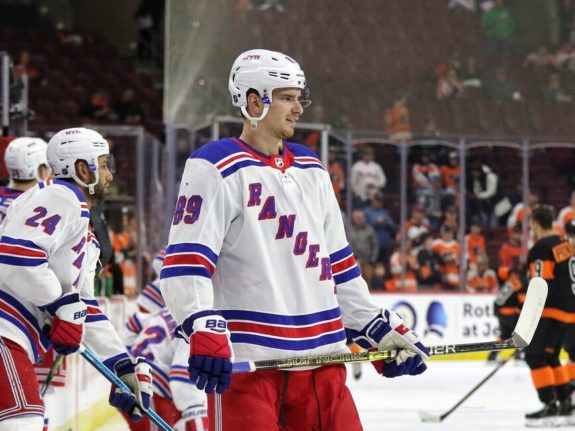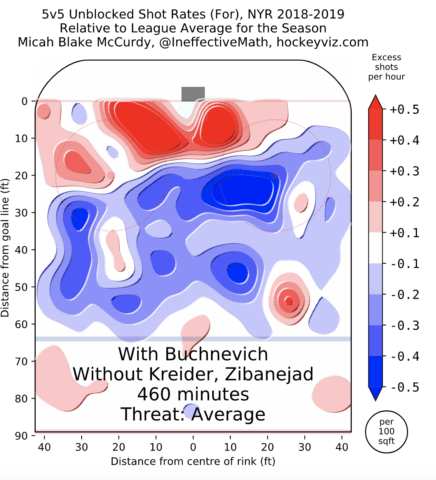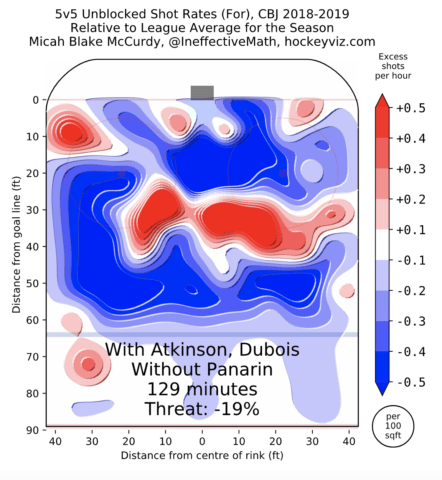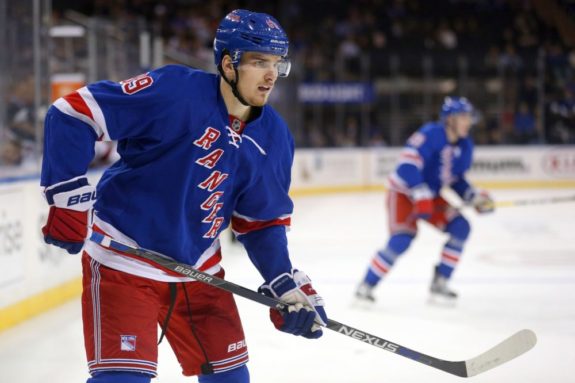It seems that every offseason, Pavel Buchnevich’s expectations from the New York Rangers’ community are spread wide and thin. Some believe he’s capable of a 70-point campaign, while others still think his lack of physicality and large frame makes him a target for turnovers and inconsistency. His third season was thought to be his quintessential breakout year on an offensively challenged Rangers’ squad, yet his play remained lackluster.
Buchnevich has yet to prove himself as a regular top-six contributor, evident by the Rangers’ hesitance to hand him a long-term contract. His rookie campaign saw him produce 20 points in 41 games, then 43 points in 74 games, and finally 38 points in 64 games this most recent season.

Here we are again with Buchnevich, seemingly poised for a breakout season, but there are a few evident reasons why the 2019-20 season has the 24-year-old Russian in a better position than ever to meet his full potential. It’s also come at a time where his top six position is in doubt due to the emergence of young forwards joining the fray. Amongst all Rangers, this upcoming season is perhaps the most important for Buchnevich and his future role with the team.
Reliance on Linemates
Through the first three years of his career, Buchnevich has struggled to consistently drive offense as a solo force while also remaining responsible in his own zone. This past season, he played 460 minutes at 5-on-5 strength without Chris Kreider or Mika Zibanejad on his line. In that timespan, Buchnevich struggled to drive more than an average amount of offense and was well below the league average for defensive shot suppression.

On the flip side, Kreider and Zibanejad were still able to remain over the league average in both shot creation and possession without Buchnevich on their line. That’s not to say that he is completely ineffective without his linemates, nor does he weigh them down when they were all together. However, his reliance on who he’s paired with must be taken into consideration when building expectations. That being said, Buchnevich finds himself lined up with two of the Rangers’ most effective shot driving forwards for the upcoming season.
The Effect of Artemi Panarin
Buchnevich may struggle with driving offense all by his lonesome, but he’ll be lined up opposite to a player that thrives in offensive zone entries and shot driving possession. The top line of Artemi Panarin, Zibanejad, and Buchnevich has quickly emerged as an exciting, fast-paced and offensively gifted combination. Thus far in the preseason, they own three of the top four spots in Corsi-For percentage, floating around the 60% mark.
In the Rangers’ most recent preseason match against the New York Islanders, only Buchnevich and Panarin were above the 20% mark in relative-Corsi at 5-on-5 strength (23.33% and 24.56% respectively). To put that in perspective, those are the two highest single-game CF%-Rel of the preseason for the Rangers.
The two were the top players in the contest and seemingly possess a chemistry that’s unwarranted amongst the rest of the team. Preseason numbers can be skewed due to the quality of competition, but they still provide a small sample size into what regular-season numbers may look like. If there was any indication of the preseason, it’s that Buchnevich and Panarin are in a position to both thrive in shot creation.
This past season, Panarin’s linemates of Cam Atkinson and Pierre-Luc Dubois were greatly effected when all three weren’t paired together. Without Panarin, Atkinson and Dubois were practically useless in both ends of the ice at 5-on-5 strength.

To say that Panarin positively impacts his linemates would be a massive understatement. He individually drives an offense and creates space just with his presence on the ice. Buchnevich may not individually be a top-line winger, but Panarin has the ability to transition him into one.
David Quinn’s Added Trust
Perhaps the most telling reason why Buchnevich can transition into a regular top-six winger is David Quinn’s notable trust in him. It’s not often that a coach vocally commits to a top line without having even seen them play a regular-season game yet. Perhaps this was to inspire Kaapo Kakko or Vitali Kravtsov, but Quinn’s dedication to the top line has put plenty of pressure on Buchnevich. By no means has he proven himself to be the top right-winger on the team, especially after an injury-shortened 38-point campaign. Yet, Quinn still has committed himself to the top line, giving Buchnevich a golden opportunity to flourish.

One has to believe that Quinn believes the Russian connection between Buchnevich and Panarin will lead to added chemistry. Neither have played on the same line as a KHL alumnus since arriving in the NHL. Panarin has already spoken about the positives of having a fellow Russian by his side, both on and off the ice. Buchnevich’s presence on the first line does more than provide Panarin with a playmaking winger, it brings a familiarity and comfort in communication with a linemate.
The 2019-20 season will be a tumultuous time for Buchnevich. Between somewhat disappointing 2018-19 season to his current two-year bridge deal, plenty rides on his play on the first line. He’s been given the opportunity to solidify himself as the top right-wing on the team, but he’ll have to Kakko on his coattails as the season progresses. If he can become a mainstay with Zibanejad and Panarin, the young Russian will be on his way to offensive stardom in no time.